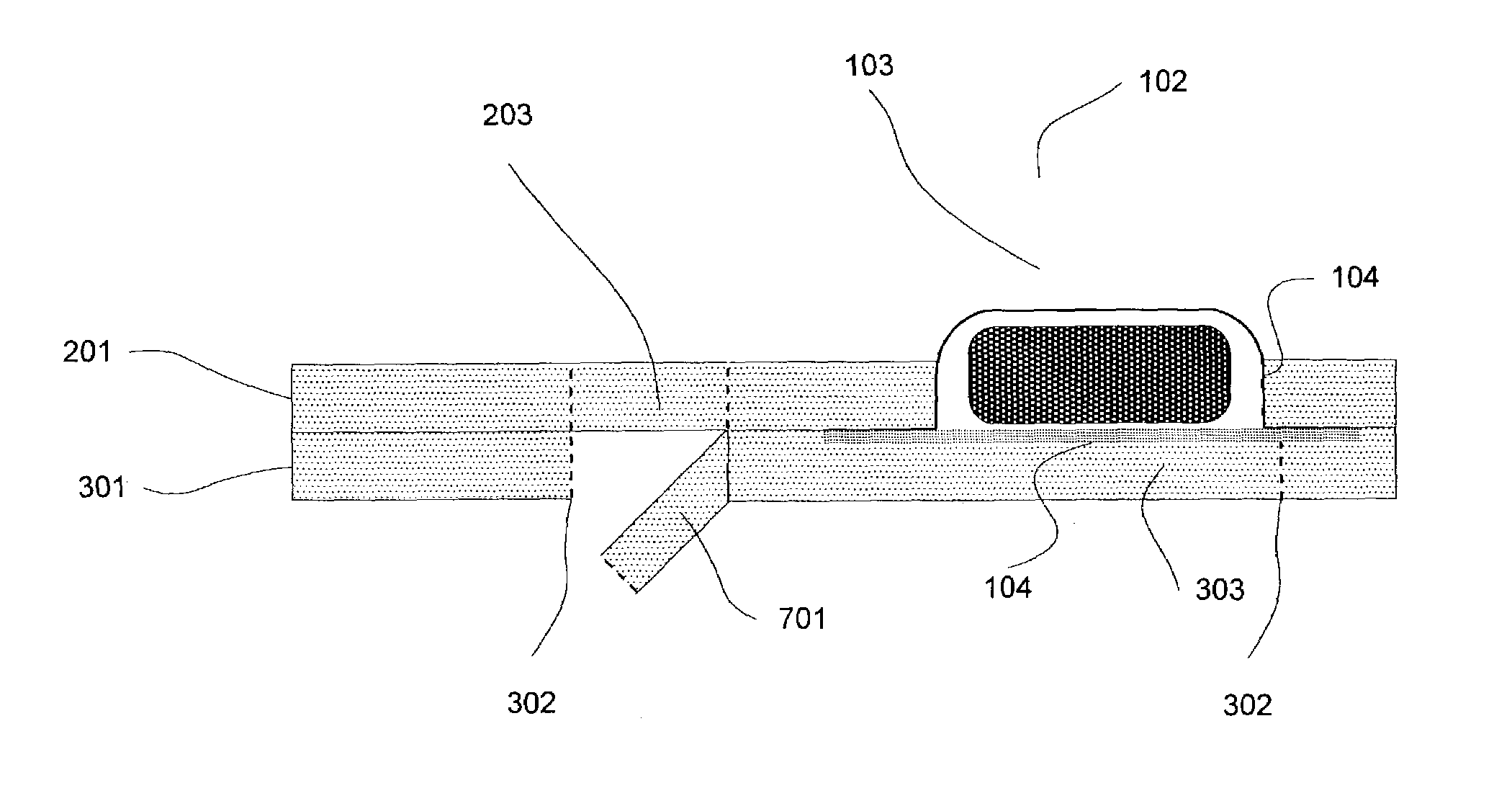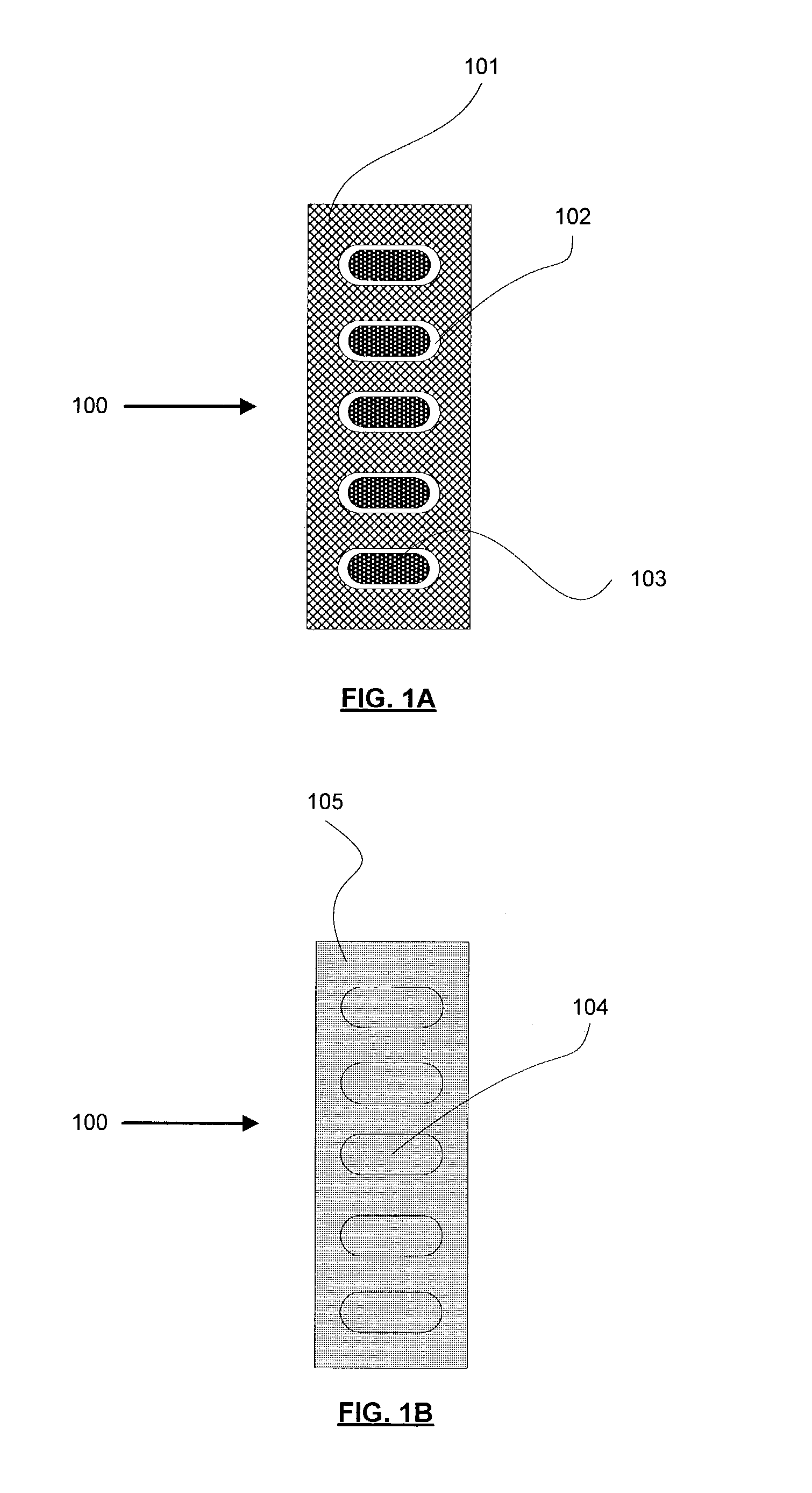Many blister card packaged products, especially pharmaceutical drugs, can be harmful, or even lethal, to children or mentally impaired adults.
At the same time, however, the products contained in blister card packages may be vital to the health of other adults including senior citizens, some of which may have impaired physical and cognitive skills and / or poor eyesight.
(Consequently, the more difficult it is for a child to access a product contained within a blister card package, the lower the child-resistance rating applied to the packaging).
After the aforementioned modifications were made, many blister card packages that were previously non-child-resistant were able to pass child resistance testing, however, the packaging became undesirable in other ways.
For example, the additional, reinforced layers often prevented the pills from being pushed cleanly through the blister backing and thereby caused degradation of the backing of other adjacent pills.
This can be very difficult, especially for senior citizens or other adults with impaired physical abilities.
Furthermore, once the backing is grasped and torn, a user can easily tear too much backing, exposing other blisters.
Consequently, the child resistance capabilities of the adjacent blister with the partially torn backing is lessened, thereby creating a potentially lethal hazard for children.
Additionally, the user may not be able to scrape the backing to the point where the backing may be pulled, causing the user to resort to a sharp object such as a knife or scissors.
Cutting of the blister card packaging can lead to many more problems including degradation of the child resistance properties of the other blisters, damage to the unused pills, damage to the printed instructions advising the user when and how to take the pills, etc.
This leads to at least two major problems.
First, damage may result to the content of the blister rendering those contents unusable.
For example, if the blister contains a pharmaceutical drug contained in capsule form, the pressure exerted on the capsule may cause the capsule to burst, rendering it unusable.
This can be very dangerous to the health of the user.
Second, the user may resort to bending the overall blister card package causing damage to the blister, adjacent blisters, blister backings, and the content of the blisters, which again may be very dangerous to the health of the user.
All of the aforementioned problems exist with the blister card packages known in the art.
In addition to the safety concerns discussed above, inferior blister card packaging also increases the cost of pharmaceutical drug clinical trials, which are required by the Federal Food and Drug Administration (“FDA”).
If the empty blister card package is degraded, the clinical trial participant may be exposed to the drug identification, causing that participant's results to be discarded.
The reason for this is that if a participant is aware of which pill is a placebo versus an actual drug, the participant's response to each pill may be compromised because they are expecting a certain response.
Therefore, use of blister card packages that are easily degraded adds to the cost of clinical trials because another participant must be found, and possibly paid, and a supervising physician must be paid to supervise the additional participant, which may cost the drug manufacturer as much as $50,000 per participant.
Depending on the effectiveness of the blister card package, among other factors, a pharmaceutical company may be required to recruit 120 participants to expeditiously complete a clinical trial requiring 80 successful participants, thereby unnecessarily adding to the cost of clinical trials.
A few problems exist with peel-push blister card packaging.
One such problem is the difficulty involved with grasping the outer layer such that it may be peeled.
Since many outer layers are difficult to grasp, users tend to bend the overall packaging or use sharp objects to remove the outer layer, which results in damage to the packaging of the remaining products.
In particular, some of these outer layers are so difficult to grasp that senior citizens or other adults suffering from diminished physical abilities or poor eyesight may not be able to access the blister product without assistance.
Also, the damage to the remaining packaging diminishes its child resistance.
Another problem with peel-push packaging is that even if the user is able to grasp the outer layer, the user sometimes removes more of the outer layer than that which covers the desired product.
Again, this problem causes the child resistance rating of the adjacent product to be reduced, if not totally eliminated.
The blister card packaging disclosed in Davie suffers the same limitations as other peel-push packaging, i.e., it is difficult to grasp the outer layer prior to peeling and the Davie product is actually designed to expose the frangible layer of products that are not ready to be removed.
This aspect obviously diminishes the child resistant capabilities of the unopened package.
Although Dlugosz discloses a better method of grasping the tear strip, Dlugosz still requires bending the packaging.
Also, Dlugosz does not disclose a method that prevents the user from tearing more of the backing than necessary to expose the frangible layer of the desired product.
Finally, the tear strip may still be difficult to grasp for senior citizens or other adults suffering from diminished physical abilities.
Although the Intini '004 patent discloses a better method of grasping the outer non-frangible layer, the Intini '004 patent still requires bending the packaging which may be difficult for frail adults, especially those suffering from an ailment such as arthritis.
Furthermore, because the Intini '004 patent requires both foil and paper frangible layers, it is difficult to push the product through the two frangible layers.
This added resistance makes the card unsuitable for soft capsules, gel caps, and soft tablets / caplets.
Furthermore, seniors have a more difficult time pressing products through the thicker frangible layers.
Although the additional layer containing the T-shaped perforation may provide a higher child resistance rating, the additional layer also adds another level of complexity for those users who suffer from diminished physical abilities or poor eyesight.
Similar to the packaging disclosed in Bitner, although the additional complexity required to access the content of the blister might achieve a higher child resistance rating, the additional complexity also makes the content of the blister less accessible to those users who suffer from diminished physical abilities or poor eyesight.
The packaging disclosed in Matthews suffers from the same limitations as the aforementioned packaging containing two distinct layers, namely, the additional level of complexity required to access the product and the possibility that the user tears more of the backing than required, thereby reducing the child resistant properties of the packaging of the remaining products.
However, these limitations are magnified by the addition of a third layer, i.e., the outermost, non-frangible layer.
Again, the Vasquez packaging requires multiple, intricate steps that will be difficult to perform by users suffering from diminished physical abilities or poor eyesight.
Again, when the blister card packaging is used to package pharmaceutical drugs, removing the non-frangible layer from an entire row of pills degrades the child resistance of the pills in the row that are not immediately removed.
However, none of these patents disclose a method that prevents the user from removing more of the backing than that which covers the intended blister or blisters.
In contrast, if the rigidity of the perforated ovals is high, the Godfrey packaging impedes access to the blisters' content for adults having impaired physical abilities.
These three steps can be very difficult for a senior citizen, or other adult, having impaired physical abilities.
Such individuals may resort to sharp objects for removal of any of the aforementioned layers, which is likely to damage the packaging.
In a clinical trial, the results of a participant that returns damaged, empty packaging may be discarded, thereby increasing the total number of participants and the cost of the clinical trial.
Whereas the lack of adhesion between the outer and inner layers of the backing facilitate removal of the backing, the multiple peels required to remove the blister's content renders the Danville packaging difficult for adults having impaired physical abilities.
The blister card packaging disclosed in Swartz does not contain a method of preventing more than the desired backing from being torn.
Additionally, the pressure exerted on the packaging to form the pull-tab may damage the packaging.
 Login to View More
Login to View More 


